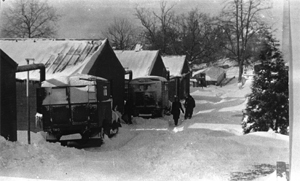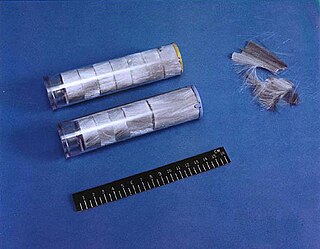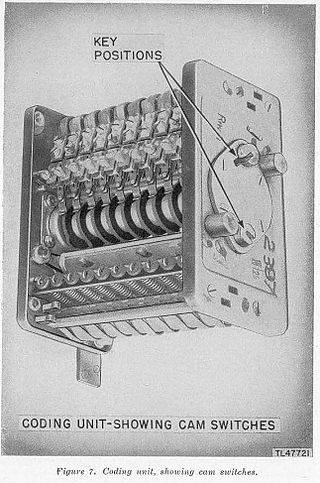Related Research Articles
The Battle of the Beams was a period early in the Second World War when bombers of the German Air Force (Luftwaffe) used a number of increasingly accurate systems of radio navigation for night bombing in the United Kingdom. British scientific intelligence at the Air Ministry fought back with a variety of their own increasingly effective means, involving jamming and deception signals. The period ended when the Wehrmacht moved their forces to the East in May 1941, in preparation for the attack on the Soviet Union.

H2S was the first airborne, ground scanning radar system. It was developed for the Royal Air Force's Bomber Command during World War II to identify targets on the ground for night and all-weather bombing. This allowed attacks outside the range of the various radio navigation aids like Gee or Oboe, which were limited to about 350 kilometres (220 mi) of range from various base stations. It was also widely used as a general navigation system, allowing landmarks to be identified at long range.

The Naxos radar warning receiver was a World War II German countermeasure to S band microwave radar produced by a cavity magnetron. Introduced in September 1943, it replaced Metox, which was incapable of detecting centimetric radar. Two versions were widely used, the FuG 350 Naxos Z that allowed night fighters to home in on H2S radars carried by RAF Bomber Command aircraft, and the FuMB 7 Naxos U for U-boats, offering early warning of the approach of RAF Coastal Command patrol aircraft equipped with ASV Mark III radar. A later model, Naxos ZR, provided warning of the approach of RAF night fighters equipped with AI Mk. VIII radar.

The Lichtenstein radar was among the earliest airborne radars available to the Luftwaffe in World War II and the first one used exclusively for air interception. Developed by Telefunken, it was available in at least four major revisions, called FuG 202 Lichtenstein B/C, FuG 212 Lichtenstein C-1, FuG 220 Lichtenstein SN-2 and the very rarely used FuG 228 Lichtenstein SN-3.. The Lichtenstein series remained the only widely deployed airborne interception radar used by the Germans on their night fighters during the war — the competing FuG 216 through 218 Neptun mid-VHF band radar systems were meant as a potentially more versatile stop-gap system through 1944, until the microwave-based FuG 240 "Berlin" could be mass-produced; the Berlin system was still being tested when the war ended.

Oboe was a British bomb aiming system developed to allow their aircraft to bomb targets accurately in any type of weather, day or night. Oboe coupled radar tracking with radio transponder technology. The guidance system used two well-separated radar stations to track the aircraft. Two circles were created before the mission, one around each station, such that they intersected at the bomb drop point. The operators used the radars, aided by transponders on the aircraft, to guide the bomber along one of the two circles and drop the bombs when they reached the intersection.

No. 100 Group was a special duties group within RAF Bomber Command. The group was formed on 11 November 1943 to consolidate the increasingly complex business of electronic warfare and countermeasures in one organisation. The group was responsible for the development, operational trial and use of electronic warfare and countermeasures equipment. It was based at RAF stations in East Anglia, chiefly Norfolk.

H2X, eventually designated as the AN/APS-15, was an American ground scanning radar system used for blind bombing during World War II. It was developed at the MIT Radiation Laboratory under direction of Dr. George E. Valley Jr. to replace the less accurate British H2S radar, the first ground mapping radar to be used in combat. H2X was also known as the "Mickey set" and "BTO" for "bombing through the overcast" radar.
Gee-H, sometimes written G-H or GEE-H, was a radio navigation system developed by Britain during the Second World War to aid RAF Bomber Command. The name refers to the system's use of the earlier Gee equipment, as well as its use of the "H principle" or "twin-range principle" of location determination. Its official name was AMES Type 100.

The Telecommunications Research Establishment (TRE) was the main United Kingdom research and development organisation for radio navigation, radar, infra-red detection for heat seeking missiles, and related work for the Royal Air Force (RAF) during World War II and the years that followed. It was regarded as "the most brilliant and successful of the English wartime research establishments" under "Rowe, who saw more of the English scientific choices between 1935 and 1945 than any single man."

Chaff, originally called Window or Düppel, is a radar countermeasure involving the dispersal of thin strips of aluminium, metallized glass fiber, or plastic. Dispersed chaff produces a large radar cross section intended to blind or disrupt radar systems.
Serrate was a World War II Allied radar detection and homing device that was used by night fighters to track Luftwaffe night fighters equipped with the earlier UHF-band BC and C-1 versions of the Lichtenstein radar. It allowed Royal Air Force (RAF) night fighters to attack their German counterparts, disrupting their attempts to attack RAF bombers.
The Rainbow Codes were a series of code names used to disguise the nature of various British military research projects. They were mainly used by the Ministry of Supply from the end of the Second World War until 1958, when the ministry was broken up and its functions distributed among the forces. The codes were replaced by an alphanumeric code system, consisting of two letters followed by three digits.
The Lorenz beam was a blind-landing radio navigation system developed by C. Lorenz AG in Berlin for bad weather landing. The first experimental system had been installed in 1932 at Berlin-Tempelhof Central Airport and was demonstrated at the International Air Service Conference in January, 1933. Further improvements of the system were accepted during the meetings in November. 1933 and September 1934. By 1937 in addition to German airports the Lorenz System was employed in Europe, e.g. London, Paris, Milan, Stockholm, Warsaw, Vienna and Zürich, as well as internationally in Japan and Russia, with additional systems in preparation in Australia, South America and South Africa. The Lorenz company referred to it simply as the Ultrakurzwellen-Landefunkfeuer, German for "ultra-short-wave landing radio beacon", or LFF. In the UK it was known as Standard Beam Approach (SBA).
During World War II, the German Luftwaffe relied on an increasingly diverse array of electronic communications, IFF and RDF equipment as avionics in its aircraft and also on the ground. Most of this equipment received the generic prefix FuG for Funkgerät, meaning "radio equipment". Most of the aircraft-mounted Radar equipment also used the FuG prefix. This article is a list and a description of the radio, IFF and RDF equipment.

The FuG 240 "Berlin" was an airborne interception radar system operating at the "lowest end" of the SHF radio band, which the German Luftwaffe introduced at the very end of World War II. It was the first German radar to be based on the cavity magnetron, which eliminated the need for the large multiple dipole-based antenna arrays seen on earlier radars, thereby greatly increasing the performance of the night fighters. Introduced by Telefunken in April 1945, only about 25 units saw service.

FuG 25a Erstling was an identification friend or foe (IFF) transponder installed in Luftwaffe aircraft starting in 1941 in order to allow German Freya radar stations to identify them as friendly. The system was also used as a navigation transponder as part of the EGON night bombing system during 1943 and 1944. It was the second German IFF system to be used, replacing the FuG 25 Zwilling.

Radar, Aircraft Interception, Mark IV, also produced in the USA as SCR-540, was the world's first operational air-to-air radar system. Early Mk. III units appeared in July 1940 on converted Bristol Blenheim light bombers, while the definitive Mk. IV reached widespread availability on the Bristol Beaufighter heavy fighter by early 1941. On the Beaufighter, the Mk. IV arguably played a role in ending the Blitz, the Luftwaffe's night bombing campaign of late 1940 and early 1941.
German Luftwaffe and Kriegsmarine Radar Equipment during World War II, relied on an increasingly diverse array of communications, IFF and RDF equipment for its function. Most of this equipment received the generic prefix FuG, meaning "radio equipment". During the war, Germany renumbered their radars. From using the year of introduction as their number, they moved to a different numbering scheme.
The Y-Control System is a radio guidance system. By late 1943 the Luftwaffe was facing multiple problems in navigation and control of its assets in the European airspace. Allied jamming of existing VHF voice radio links and MF navigation beacons was becoming extremely effective, At the same time training of pilots was being curtailed by the lack of fuel. This resulted in fighter formations being unable to find the allied bombers and frequently getting lost. Work was then carried out with regards to solving these issues. Part of the research resulted in the radio systems such a Hermine and Bernhard. However a simpler system that could be rolled out faster and was usable by minimum hour pilots in single seat fighters was also developed.

Airborne Cigar, or ABC for short, was a World War II electronic countermeasure (ECM) system developed by the Telecommunications Research Establishment (TRE) to jam Luftwaffe ground-to-air radios operating in the very high frequency (VHF) band. When used properly, the system made enemy night fighter communications almost impossible. The Germans referred to ABC as "dudelsack", German for bagpipes, in reference to the warbling sound.
References
- Harris, Arthur Travers (1995). Cox, Sebastian (ed.). Dispatch on War Operations: 23rd February, 1942, to 8th May, 1945. London: Routledge. ISBN 0-7146-4692-X.